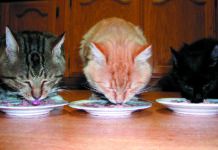Cats are notoriously reluctant to change — and this is especially true when making a change from a preferred diet. Low protein diets for kidney disease can be less palatable, which can make the change especially difficult for some cats. Switching food should be done slowly, and a smooth transition can take a few days up to 10 days for some.
You should start with a blend of current food, about 80 percent, and a small amount of the new food (approximately 20 percent). Feed this blend for a few days until your cat happily eats it. Over the course of several days, gradually increase the amount of new food while decreasing the amount of the old food. Warming the canned food slightly can increase interest in the food as well as palatability.
With time and patience, most cats can be transitioned to a new diet — which is especially important since diet is an integral part of managing kidney disease. It may take more time than you originally planned, but the payoff will be worthwhile. However, keep in mind that some cats take a little longer while others will never transition. If your cat refuses to eat the new food, don’t try to wait it out and assume he’ll eat when he gets hungry enough. Never starve your cat; continue to feed the old food and talk to your veterinarian about other options. It’s also not a good idea to try to transition your cat to a new diet when she is feeling sick — nauseated or vomiting — from the kidney disease. It is best to get her stabilized and feeling better, and then try for a diet transition.


